
Meet the artists featured in the exhibition, The World of Frida, organized by the Bedford Gallery in Walnut Creek, CA. Every other week we will highlight a few of the artists included in the exhibition. The 95 international artists featured in The World of Frida have reinterpreted many aspects of Frida Kahlo’s life in an array of media — from honoring her self-portraits, to depicting her love affair with Diego Rivera, to recognizing her emotional, physical, professional and societal struggles. This exhibition is an incredible tribute to an artist who continues to influence millions by the simple fact that she was always true to herself, no matter the cost.
Dion Dion
Manchester, MO
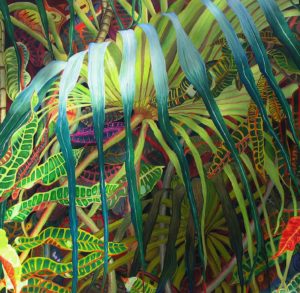
Dion Dion, SunKissedFrond, 2010, oil on canvas, 36 x 36 in.
Dion Dion is a highly accomplished educator and practicing artist. Dion has worked in clay, handmade paper, mixed media sculpture and now in oil paintings and mixed media. Her works are in private, corporate and museum collections.
Dion has served as an adjunct art instructor with Maryville University and recently served as director of the Emerging Artists as Entrepreneurs program for the Saint Louis Art Fair. She has also served on the Board of Directors for Manchester Arts, operating as the Visual Arts Director. Previously, Dion was executive director of Art Saint Louis for 18 years. In her work with a variety of non-profit arts organizations for over 35 years, she has served as president, program director and on the Board of Directors of numerous arts organizations. As a professional arts administrator and consultant, she has served as juror, curator, director or awards judge for over 250+ local, regional and national and international exhibitions, festivals, conferences and major artists’ presentations and performances. Designated a Master Teacher of Art, she was an art educator for 15 years at the secondary level where she designed and taught the curriculum for gifted art students and served on state teams evaluating high school art departments for state and national accreditation.
Carlo Fantin
Bay Area, CA
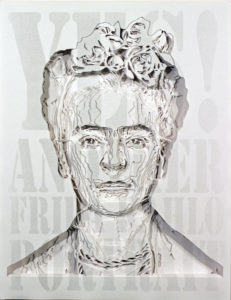
Carlo Fantin, Yes Another Frida Kahlo Portrait, 2018, hand-cut paper, 15 x 12 in.
Carlo Fantin was born and raised in Italy, and moved to the Bay Area in 2007. He has been drawn to various forms of expression, from sculpture, drawing, and painting to furniture and industrial design.
Carlo Fantin was raised in Italy, and his mother was devoutly Catholic. His earliest significant exposure to art was through the iconography of religious figures in The Basilica di San Marco in Venice. The way The Virgin Mary and “endless numbers” of saints were venerated in paintings and sculpture was powerful. Eventually, Fantin also became fascinated with the parallels between religious worship and contemporary obsessions. So many saints are worshipped in Italy, Fantin says, and any given worshiper’s predominant preoccupations will lead him to be especially devoted to a particular saint (or vice versa, one supposes). Within a working analogy of the internet as modern-day religion, and social networking as contemporary churchgoing, we follow “modern saints” such as blogs and YouTube channels, and can find always another Virgin Mary to adore amongst celebrity Twitter pages. Fantin’s current vein of work, iconographic imagery in a “lacework tapestry” of hand-cut paper – not unlike a Basilica’s stained-glass windows – is crafted with a precision and intricacy that evokes obsessive fervor.
Rupert García
Bay Area, CA
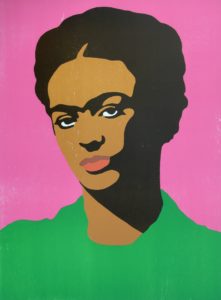
Rupert García, Frida Kahlo, 2002/1975, woodcut print, 43 x 33 in. Courtesy of Magnolia Editions, Oakland, CA
Contemporary artist Rupert García is known as much for the political power of his work as for his strong, evocative graphics and rich colors. Between 1967 and 1975 he became recognized for his political posters, which dealt with race, politics, and the Vietnam War. García’s silkscreen posters, etchings, paintings, and pastel portraits have been featured in hundreds of exhibitions. He has taught art in the Bay Area since 1969.
García has proven himself to be not only one of the most important artists of the last twenty-five years, but an important political force as well. Much of his work has dealt with issues of racism and the mistreatment of Latinos in the United States. His style is direct and powerful; he seeks to be both forceful and readily accessible to a wide audience. Keeping these goals in mind, both García’s graphic art and paintings display a skillful unification of the Mexican tradition of Rivera, Siqueiros and Orozco, with elements learned from European artists and those of the American Pop art movement. García’s art has evolved stylistically throughout his career, but he has constantly maintained a strong balance of graphic and “fine art.”
García has also played an important role in Latino art scholarship. He holds two M.A. degrees—one in studio art and the other in art history. He is the author of an important thesis on California Chicano Muralists and has published essays on a number of different subjects including the work of Frida Kahlo. García’s continuing legacy constantly addresses the most important issues of contemporary society, both thematically and stylistically.
Catherine Hicks
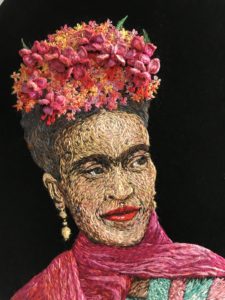
Catherine Hicks, Diego’s Chica, a portrait of Frida, 2014, silk and metallic crewel embroidery and stump work, 12 x 9 in.
Artist’s Statement
A primarily self taught artist, I eventually asked myself the questions that would come to define my work: What if paintbrushes had never been invented? What if pigment and oil had never been mixed? What if female creativity had ascended, and men’s work had been dismissed as “craft?” With no paint, how might art have been expressed, and who, exactly, might have done the talking?
All of my work is wired and stitched from artistic memory, as an ongoing call and response between myself and artists of the past. Everything I make is some sort of recuerdo; a way of communing with the painters I wish I had known by more than what was left in biographies and hanging on museum walls.
Sometimes appropriating self and photographic portraits, or by using art history as a foil, I explore the lives and work of significant artists by reinterpreting or reimagining their work through a medium that undoubtedly precedes (but did not survive as easily as) mark making with pigment.
With a provocative wink, my work explores art history through feminine – now feminist tools: needles, wire and thread. With meditative stitches and hidden structure, I imbue flat planes of shadow with visual images that leap dimensionally forward in depth that is present and unabashedly real.
Jeni Jenkins
Cincinnati, OH
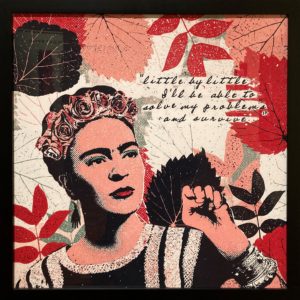
Jeni Jenkins, Little By Little, 2018, four color serigraph
Artist Statement
I am a graphic designer, artist and educator. I am currently working on a body of work exploring the social construction of race, sexuality, gender, and class in the historical context of the United States.
My modus operandi is to be involved in meaningful work that makes a positive impact on the lives of others. I believe I have the power to create significant change. Since 2001, I have studied, trained, and worked on issues of inclusion, equity, and empowerment. I devoted my career to social justice: from working in a University women’s center; to running an LGBTQ advocacy organization; to teaching Women’s & Gender Studies at a Kentucky college; to creating a community newspaper that amplifies the voices of community members; to utilizing my technical skills in marketing and visual communications at grassroots non-profits. Currently, I work at a soup kitchen in one of the poorest neighborhoods in Cincinnati. The work I do daily is all about making sure that poor people have access to food and social services. My impact is limited here because the work fails to adequately address structural inequalities, however it is still extremely meaningful.

